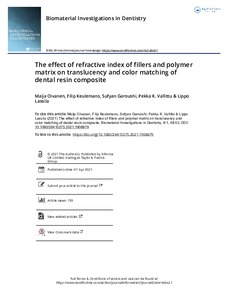The effect of refractive index of fillers and polymer matrix on translucency and color matching of dental resin composite
Oivanen Maija; Keulemans Filip; Garoushi; Sufyan; Vallittu Pekka K; Lassila Lippo
https://urn.fi/URN:NBN:fi-fe2021042825789
Tiivistelmä
Objective: When restorative resin composites absorb light from the surrounding tooth structures, it creates a color-match, which is known as 'a chameleon effect'. In this study, series of co-monomer mixtures were prepared with an increasing refraction index (RI) and mixed with glass fillers. The aim of this study was to optimize the mismatch of RI of resin/fillers to create the chameleon effect.
Materials and methods: BisGMA/TEGDMA resins were prepared with seven different mix fractions from 20 to 80%. Two different series (A&B) of submicron (Ø 0.7 μm) silanized fillers (70 wt%) (A: Schott RI = 1.53, B: Esschem RI = 1.54) were mixed with resins (30 wt%). Disc-shaped specimens (1 mm thickness, Ø10 mm) for each composite combination (n = 3) were prepared and light cured for 20 s. Commercial resin composite (OmniChroma, Tokuyama Dental) was used as control. The translucency parameter (TP) was measured using a spectrophotometer. The color matching abilities of the experimental composites were visually analyzed. Data were statistically analyzed using ANOVA.
Results: The composition of resin and type of fillers had a statistically significant effect on TP values (p < .05). The highest TP values were achieved around 50%-50% fractions of Bis-GMA and TEGDMA for series A and around 60%-40% fraction of Bis-GMA and TEGDMA for series B. Data showed that a high or low fraction of BisGMA resulted in a low translucent composite. Experimental resin composite (80% Bis-GMA) from series A was behaving similarly to Omnichroma in reference to TP values and color matching.
Conclusions: Including fillers with RI of 1.53 into BisGMA/TEGDMA resin with RI of 1.524 resulted in composite resin providing a good color match with surrounding structure 'chameleon effect'.
Kokoelmat
- Rinnakkaistallenteet [27094]
